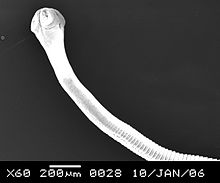Davaineidae is the name of a family of tapeworms that includes helminth parasites of vertebrates.[1] Of the 14 genera recorded under this family, Raillietina is the best understood and most extensively studied. Members of the family are characterized by the presence of a crown (rostellum) at the tip of the scolex, and the rostellum is made up of mattock- or hammer-shaped hooks. The rostellum is surrounded by suckers which are armed with spines.[2] These tapeworms are most commonly found in birds, and in few cases, mammals, which are the definitive hosts. Intermediate hosts are small insects such as ants.[3] Hosts of Davainea proglottina (length 1 – 4 mm), for example, are chickens. Slugs are the intermediate hosts.[4]
| Davaineidae | |
|---|---|
 | |
| SEM of Raillietina tetragona | |
| Scientific classification | |
| Domain: | Eukaryota |
| Kingdom: | Animalia |
| Phylum: | Platyhelminthes |
| Class: | Cestoda |
| Order: | Cyclophyllidea |
| Family: | Davaineidae Braun, 1900 |
Genera
- Calostaurus Sandars, 1957
- Cotugnia Diamare, 1893
- Davainea Blanchard, 1891
- Fernandezia Lopez-Neyra, 1936
- Fuhrmannetta Stiles & Orleman, 1926
- Houttuynia Fuhrmann, 1920
- Idiogenes Krabbe, 1868
- Ophryocotyle Friis, 1870
- Otiditaenia Beddard, 1912
- Paroniella Fuhrmann, 1920
- Paspalia Spasskaya & Spasskii, 1971
- Pseudidiogenes Movsesyan, 1971
- Raillietina Fuhrmann, 1920
- Skrjabinia Fuhrmann, 1920
References
External links
Wikiwand in your browser!
Seamless Wikipedia browsing. On steroids.
Every time you click a link to Wikipedia, Wiktionary or Wikiquote in your browser's search results, it will show the modern Wikiwand interface.
Wikiwand extension is a five stars, simple, with minimum permission required to keep your browsing private, safe and transparent.
